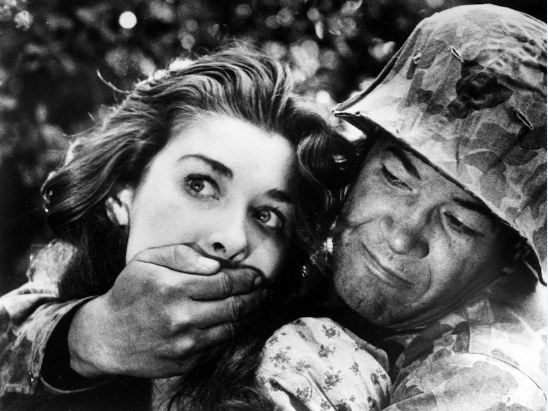What’s up, Contenders? Terry Malloy here reporting live from the Waterfront.
I’ve been plotting to finally see the entire filmography of Stanley Kubrick in recent months. (I know, I know: it is a full on tragedy that I haven’t seen them all!) And while I’m at it I am hoping to revisit the films I have seen as well. After all, Kubrick really didn’t direct all that many films over the course of his career.
And as it turns out, there is more than one film that the contentious director created only to then actively seek to suppress. I’ve always heard that he disavowed SPARTACUS, but until recently I had never even heard of an early work of his entitled FEAR AND DESIRE, which he also distanced himself from. Unlike SPARTACUS, in this instance I can see why the filmmaker discouraged viewings of FEAR AND DESIRE.
While this certainly isn’t a major embarrassment, it really isn’t the kind of lost filmic masterpiece that I had hoped to stumble across when Kino Classics released the film on Blu-ray this week.

Kino is releasing the film as a result of a recent restoration of the film by the Library of Congress. The Blu-ray is also packaged with THE SEAFARERS, which is essentially an internal union recruitment video for the Seafarers International Union (or the SIU) which Kubrick happened to both shoot and direct.
As the headline suggests, I think this release might be fascinating to film preservationists who are actively and heroically bringing many older films back from the brink of extinction and lovingly restoring them and digitizing them one frame at a time. To all film lovers, this work should be considered a hallowed profession. And the creation of a wide release for an early Stanley Kubrick film that was extremely rare is important and note-worthy.
But there are many reasons why Kubrick himself probably wanted to see this film disappear.
FEAR AND DESIRE is a young and intelligent director’s attempt at a metaphysical war story. It is set in a non-descript forest where four soldiers have just crash-landed behind enemy lines. A narrator tells us right away that what we are about to see isn’t really historical, but that the film will be an exploration of metaphor. And so the soldiers we meet aren’t from a particular country. Nor are the enemy soldiers that they encounter. This is actually one of the most mature and interesting aspects of the tale.
As the soldiers wrestle with what to do, complications arise and the soldiers deal with them in fairly cliché ways. First our heroes decide to build a raft in order to float out of enemy territory. But then they fear that a plane overhead has spotted them. After that they explore where the plane was headed and discover an enemy general is staying in a house nearby. And when a seemingly mute woman discovers them, our protagonists must bind her up and interrogate her in order to figure out what she knows. This confrontation results in one soldier going completely insane. The three soldiers who maintain their sanity then hatch a plan to assassinate the general, and the movie takes an even larger step into the surreal at that point.

Surreal I can appreciate. But the problem here is how broad FEAR AND DESIRE feels. The action regularly stops for our characters to have internal monologues that sound much more like a screenwriter trying to make a point than they do actual thoughts, the way that you and I think. And many of the plot elements I mentioned above feel like they are happening more to make some kind of statement on the insanity of war than they feel like an actual story that has consequence and where the outcome is meaningful to the viewer.
Look, there is some insight into the human condition that can be found in this film. There are some good points about the insanity of war or the sometimes futile concept of picking sides. FEAR AND DESIRE suggests that we may be our own worst enemies. But all of those points are made with the subtlety of a claw hammer. And a filmmaking technique that borrows heavily from other influential directors while not necessarily having a style of its own.
I’m shocked that I just wrote the above paragraph about a Stanley Kubrick film, but there it is. It is pretty clear why Kubrick discouraged screenings of this film.
There are flourishes of profundity scattered throughout FEAR AND DESIRE, most notably the way Kubrick shoots and lingers on the dead bodies in the film. The corpses here are discomforting and silent. They are effective imagery from a future master of motion pictures. But I believe I only see that profundity retroactively, because I know I am watching a future master at work. If FEAR AND DESIRE had been made by someone who had retired and gone on to sell life insurance, it would most likely have remained a forgotten film and the world wouldn’t be all that much worse for it.
All of that said, I think it IS important that this film exists and is accessible to a wide audience today. I think FEAR AND DESIRE can be a major encouragement to burgeoning filmmakers around the world. Look, we all have to learn at some point. Why not learn by doing? If Stanley Kubrick cut his teeth on documentaries for unions and with a fairly preachy debut feature, but went on to uncontested artistic greatness, so can many of you out there!
And I’m Out.
Terry Malloy AKA Ed Travis
